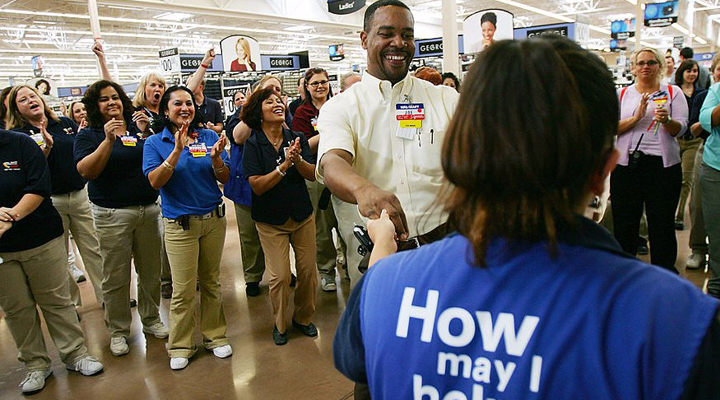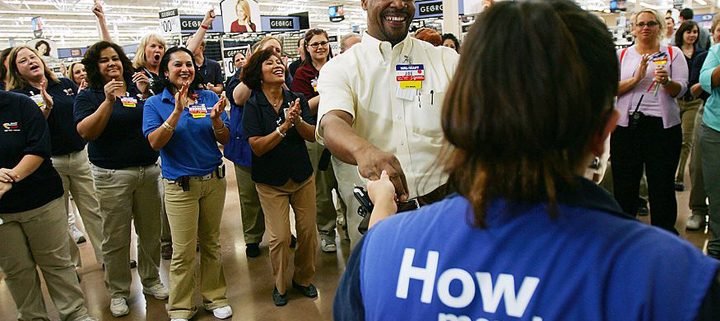Walmart and Target are struggling to compete with Amazon
Walmart and Target are struggling to compete with Amazon
Daniel B. Kline, The Motley Fool
Target and Walmart face significant challenges as American and global consumers change how they shop.
Having physical stores in convenient locations has kept both companies relevant, but it has become increasingly clear that what worked in the past will not be enough to guarantee future success.
Shoppers simply have different expectations, creating what Target called “a difficult retail environment” in its Q2 earnings release, and both companies have struggled to adapt to different degrees.
In a world that has quickly gone digital — where Amazon.com has continually refined and improved its delivery options — neither Walmart nor Target has quite come up with an answer to the online leader. Efforts to mix technology into physical stores with ideas like curbside pickup, order online/pick up in store, and enabling apps to help with in-store shopping are bandages that do not close the wound.
Target and Walmart are tackling these problems from somewhat different places, but comments and moves made by each one show they understand that it’s a changing retail world where what worked in the past may not carry the future.

File photo of employees working at a Target store at St. Albert
How did Target do?
Target, which reported results on Aug. 17, had a fairly bleak second quarter, with a comparable-sales decrease of 1.1% (its first drop since Q1 2015) and GAAP earnings per share from continuing operations of $1.07, a decrease of 11.6% from Q2 2015. If you adjust for $161 million of pre-tax early debt retirement losses, the numbers look a little better, coming in at EPS of $1.23, an increase of 0.5% over the same period last year.
That’s better, but the company’s adjusted increase comes from careful spending controls, not increased sales, and the chain has adjusted its expected comparable-sales growth for the final two quarters of the year to between flat and a loss of 2%. Q2 sales actually dropped by 7.2% and fewer people visited its stores. On the positive side, comparable digital channel sales grew 16% and contributed 0.5 percentage points to comparable-sales growth.
CEO Brian Cornell acknowledged “challenges” in his remarks in the earnings release while promising a turnaround eventually, just maybe not soon.
“Looking ahead, we remain focused on our enterprise priorities as we continue to see the benefits of investing in Signature Categories, store experience, new flex-format stores and digital capabilities,” he said. “Although we are planning for a challenging environment in the back half of the year, we believe we have the right strategy to restore traffic and sales growth over time.”
Walmart has better news
Walmart has done a better job than its rival in managing its near-term affairs. On Aug. 17, The company reported Q2 2017 revenue of $120.9 billion, an increase of 0.5% (or 2.8% on a constant-currency level). U.S. stores saw positive comparative sales for the eighth straight quarter, rising 1.6%, which the company said was driven by its seventh straight quarter of increased traffic to its stores.

David McNew/Getty Images
Global sales were up 2.2% when you exclude currency impact. On a worldwide constant-currency basis, e-commerce sales and gross merchandise volume increased 11.8% and 13%, respectively, representing an acceleration from the first quarter.
That’s good news, certainly a better result than what Target delivered, but Walmart still faces the same long-term problem as its rival: Amazon. Walmart clearly understands that because it just spent $3.3 billion to buy e-commerce company Jet.com, a money-losing company with $1 billion in net sales, and placed its CEO, Marc Lore, in charge of its entire digital operation.
The retailer also changed its digital strategy in China, selling its Yihaodian website to JD.com, the country’s No. 2 online retailer. In exchange, Walmart gets a 5% stake in JD.com, valued at roughly $1.5 billion at recent prices, and access to JD.com’sivery network and shoppers, The Wall Street Journal reported.
An attempt to catch up
For a long time, Walmart and Target had an edge over Amazon simply because they had a network of stores. However, by building up its Prime membership, which offers free two-day shipping, and increasing its shipping capacity and options (including Sunday delivery), the online retailer has made that edge less relevant.
If more customers go online, Walmart and Target could be left behind.
Walmart had $14 billion in online sales in 2015, while Amazon’s sales (which include its web services business) reached $107 billion, according to The Wall Street Journal. In FY 2016, only 3.4% of Target’s $72 billion in sales were from digital operations, slightly higher than Walmart’s 3%.
Even though Walmart stands as No. 2 to Amazon in U.S. e-commerce sales, that’s like saying that the Canadian Football League is the second-best professional football league in the world behind the NFL. It’s true in a technical sense, but the distance between the two is so great, it’s hard to imagine Walmart ever catching up, and Target barely registers as a competitor.
In May, Fortune cited eMarketer data showing that Walmart notched $12.5 billion in online sales in the last year in the U.S. while Amazon pulled in $82.8 billion.
Walmart has done a better job than Target in meeting the challenge so far, but shopping in stores has become a less necessary activity that will only become less relevant as time goes on. Both companies either need to find a way to make people buck the trend impacting nearly all physical retailers or do more online business.
Both have shown that’s possible as digital sales are at least trending up, but long-term relevancy, maybe even survival, requires a lot more work.
Disclosure: Jeff Bezos is an investor in Business Insider through his personal investment company Bezos Expeditions.



